Aluminum radiator bimetallic radiator: classification,
Winters are different, in one year, the winter can be exemplary with plenty of snow and a weak frost, but in the next year the temperature of the thermometer may well reach -20? Therefore, the choice of heating radiator should not be taken lightly, because of its design depends largely on thermal power, and hence the efficiency of heating the room.
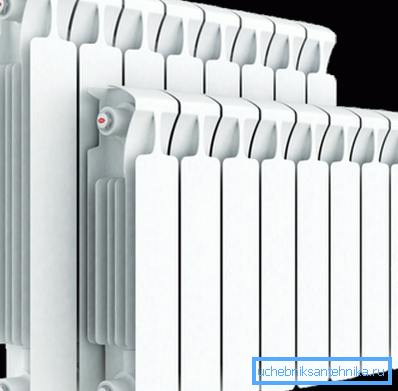
Classification of modern radiators
If we consider the design features and material, then we can distinguish such groups of heating devices as:
- cast iron - the world's first battery was made from this metal. They are characterized by high inertia, high weight and low resistance to hydraulic shocks. Both cheap models (installed in most Soviet institutions) and colored batteries with a pattern on the surface can be found on the market; the price of the latter, of course, far exceeds the cost of a conventional model;
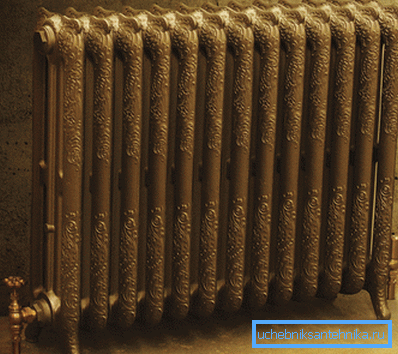
Note! Despite the high compressive strength, cast iron is a brittle material, even a blow to it can cause cracking or chipping.
- Steel panel batteries quickly heat up, cost relatively little, but if the coolant is of poor quality, steel can quickly become unusable due to metal corrosion. Weigh less than cast iron;

- aluminum - due to the higher thermal conductivity of the metal, it is possible to increase the heating power of the heater. In addition, these batteries look great, are available in a wide range of sizes, so that you can choose as an option for an ordinary apartment, and a low battery, which is suitable for rooms with windows all over the wall, the differences between bimetallic and aluminum radiators are not so great and relate mainly to the design of the device;
- bimetallic - due to the combination of a steel core and fins of another metal, it is possible to achieve strength, durability and high heat transfer. The question of how the aluminum radiator differs from the bimetallic radiator is discussed below;
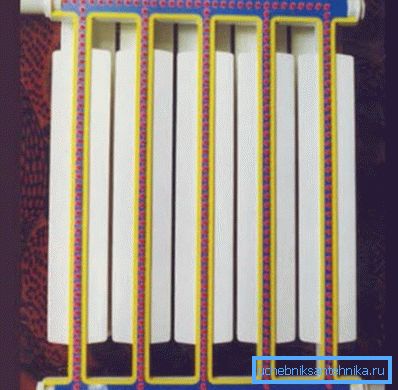
- Copper heaters are rare because of the high cost. On the other hand, copper among all metals used for the production of batteries has a maximum thermal conductivity, so that the thermal power of such heaters is at a height.
Design features
The main highlight of any bimetallic heater can be considered that it combines 2 different metals. As a rule, a durable steel frame is used - the tubes through which the coolant will circulate must withstand a possible hydraulic shock and pressure in the heating system, but the fin must have a high coefficient of thermal conductivity.
That is why the edges of bimetallic batteries are made of aluminum. Other combinations of metals are possible, for example, a copper collector + ribs from another metal, but the idea remains the same.

This is the difference between aluminum and bimetallic radiators. Aluminum models are made of a special alloy, so there can be no talk about any collector.
Comparison of bimetallic and aluminum batteries
To make the difference between bimetallic and aluminum radiators more understandable, it is more convenient to examine in detail the features of each of these heating devices.
Features of aluminum radiators
On sale you can find 2 types of such heating devices - cast and sectional. The cast ones are good because they lack seams at the junction, that is, there are fewer weak points, respectively, and the risk of heater leakage is reduced. On the other hand, casting a battery from a molten metal significantly increases its cost, hence the higher cost of such batteries.
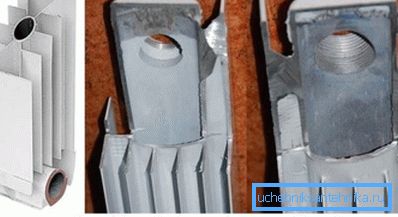
Note! In addition to the usual cast are also enhanced models. They differ from ordinary ones only by wall thickness and large working pressure in the system.
Sectional batteries may differ in the way individual sections are connected. They can be joined by welding, glue, a plug connection can also be used. Thanks to this, the replacement of sections can be done by hand. The main disadvantage of such heating devices can be considered less resistance to hydraulic shocks, and they have less working pressure.
The main problem of such batteries can be considered an increased sensitivity of the alloy to the quality of the coolant. In particular, the pH of the water should not exceed 7-8, otherwise the walls will become thinner over time, which can lead to leakage. And if in the autonomous heating system the quality of the heat carrier can still be monitored, then with centralized heat supply to the apartment there is no such possibility.
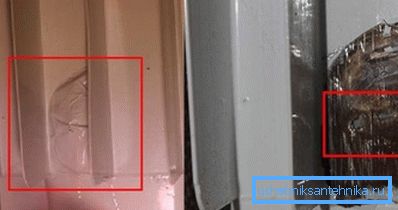
Bimetal Features
The key difference from aluminum alloy heaters is that the manifold is made of steel tubes. This gives greater mechanical strength and somewhat softer requirements for the quality of the coolant.
But as far as how to distinguish an aluminum radiator from a bimetallic radiator, it is almost impossible to make it externally, both devices have fins of the same metal.
Tip! Use a small magnet to check. It will “stick” to the bimetallic product, but not to the aluminum one.
True, another problem arises - in many models of batteries of this type the diameter of the vertical channels is very small. Such models are not suitable for centralized heating, because the risk of channel clogging is very high. In autonomous heating systems, where the quality of the coolant can be controlled, this problem will not arise.
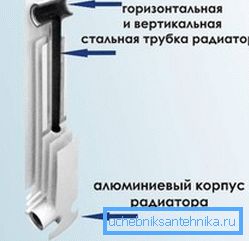
Also worth noting is the high thermal power of bimetallic radiators. The best representatives of this class of batteries demonstrate the result at the level of 200 W / 1 section.
Another parameter that distinguishes bimetallic radiators from aluminum radiators is their cost. Bimetallic devices for this indicator are among the most expensive on the market. This is explained by a more complex construction.
Comparison of aluminum and bimetal
A direct comparison of aluminum and bimetallic radiators is not entirely correct, in many respects they will go on a par, and recommendations for selection are rather related to the characteristics of the heating system.
Nevertheless, we list the main characteristics of aluminum heaters and bimetal:
- dimensions - in both cases, the model line includes both large vertical models (over 1.5 m high) and low devices for installation under large windows;
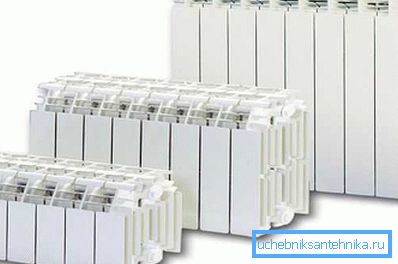
- thermal power - parity is also observed in this issue. For example, the thermal power of the aluminum battery section from Ferroli is 204 W, and the same figure for a bimetallic heater is 201 W (a series of Sira devices). So if we compare aluminum and bimetallic radiators for this indicator, we get an approximate equality;
- maximum coolant temperature highly dependent on the model. For example, for Ferroli batteries, it is about 130? C, and for the bimetallic counterpart from the manufacturer Coral Korus - as much as 150? С. But usually the maximum temperature of the coolant in the system is limited to 100-120? C;
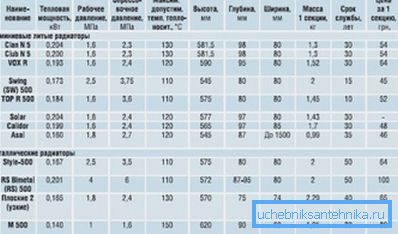
- if we compare aluminum and bimetal radiators for maximum operating pressure, then both types of batteries have a large variation in this indicator. For example, bimetallic devices from Sira are designed for 4 MPa, while products from Coral are only for 1 MPa. Aluminum picture is the same.
Note! Extrusion aluminum radiators have a high tensile strength, it can reach 120 MPa, so you can not be afraid of leaks.
So the key difference between bimetallic and aluminum radiators is only the presence of a steel frame, the role of which is performed by a manifold made of steel pipes. Recently, many manufacturers began to make it stainless steel, so that such batteries are almost eternal.
A couple of tips on choosing a battery
Knowing what is the difference between aluminum and bimetallic radiators, you can safely choose a battery for the house, you need to consider parameters such as:
- thermal power of the device. The minimum required radiator power is calculated and, based on this, a specific model is selected;

- As for which aluminum and bimetallic radiators are better, Ferroli, Rifar, Monolith, Sira have recommended themselves well. Aluminum batteries are best placed in autonomous heating systems;
- if the battery is selected in a city apartment, then it is desirable that there is a margin for the maximum working pressure. Still, no one canceled water hammer, and the safety margin will allow you to transfer it without consequences;
- cost also plays an important role;
- Also, the selection instructions require taking into account the diameter of the collector tubes. If the quality of the coolant leaves much to be desired, the narrow tubes can quickly clog up.
In conclusion
Aluminum and bimetallic radiators of heating are similar in many characteristics, and the main difference concerns their internal structure. Today, due to its attractive appearance, high heat output and ease of installation, it is these types of radiators that are most often installed in modern homes.
The video in this article presents some tips on choosing the right radiator for your home.
In the comments you can ask questions about the subtleties of choice and features of different types of radiators.